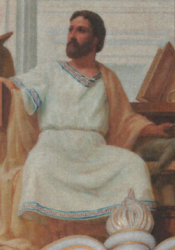Galen
Most of the prevailing anatomical beliefs of da Vinci's time were courtesy of Galen's work. Active mainly in the 2nd century, Galen both compiled existing medical knowledge and sought to further expand it through dissection of animal specimens (as dissection of human corpses was forbidden). These findings were broadly applied to human anatomy as the closest possible parallel, and were leveraged in Galen's work as chief physician to Pergamum's gladiators in 158. His discoveries included the refinement of the anatomy of the trachea (inclding the idea that the voice is generated in the larnyx), the clarification of a difference between venous and arterial blood, and the refinement of techniques for eye and brain surgery (most notably cataracts) that would not been seen again for centuries.
His work, however, was not without errors, as most animal models were not in fact close parallels to their human counterparts, as he believed. The differences between venous and arterial blood also led him to the conclusion that the circulatory system was composed of two one-way halves, one beginning in the liver and one in the heart, as opposed to a single, unified whole. He also championed the Hippocratic notion of humors, suggesting an anatomical basis for emotion and personality. Da Vinci's work with human cadavers would later refute all of these errors, despite his also possessing an intial support for humoral theory; a lack of evidence for Galen's hypotheses would convince Leonardo to eventually depart from Galenic theory altogether, and rely solely on his own empirical observations.
Sources:
"History of Anatomy." https://en.wikipedia.org/wiki/History_of_anatomy. Accessed 8 Mar. 2018.
"Galen." https://en.wikipedia.org/wiki/Galen. Accessed 8 Mar. 2018.
Image from https://en.wikipedia.org/wiki/File:Claudius_Galenus_(1906)_-_Veloso_Salgado.png

